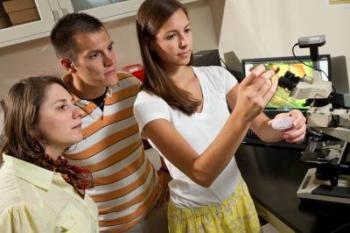Mar 25 2013
Advances in organic semiconductor technology could one day lead to video screens that bend like paper and electronics sewn into clothing.
 Oana Jurchescu and her graduate students in the Center for Nanotechnology and Molecular Materials at Wake Forest University. Credit: Ken Bennett, Wake Forest University photographer
Oana Jurchescu and her graduate students in the Center for Nanotechnology and Molecular Materials at Wake Forest University. Credit: Ken Bennett, Wake Forest University photographer
A team of researchers at Wake Forest University will help to make these flexible devices a reality by studying the relation between the physical structure and electronic properties of organic semiconductor crystals.
Their aim is to elucidate the intrinsic characteristics of single crystals and provide feedback for the development of novel, high-tech electronics and thin film devices.
A $400,000 National Science Foundation CAREER Award will support the new research. Award recipient Oana Jurchescu, an assistant professor of physics at Wake Forest University, said organic electronics have the potential to greatly impact the future semiconductor industry due to their low-cost, ease of processing, and versatility compared to the materials used now in electronic applications.
Current inorganic semiconducting materials such as silicon are processed in a vacuum at high temperatures. Jurchescu said this makes them expensive and limits their potential applications. Organic semiconductors on the other hand are not only inexpensive to process but can be applied to any medium-from metal and plastic to clothing and human skin at room temperature with spray paint or a device resembling an inkjet printer.
"Fast deposition at up to a hundred feet per second may allow their production in large volumes and at low cost per unit area, an introduction of 'electronics everywhere," Jurchescu said.
Examples of the potential technology include transparent solar cells on building windows, car roofs and bus stations, electronic displays in previously inaccessible spaces, and wearable electronics due to the organic plastics' thin, lightweight and conformal nature.
Jurchescu said her team's research will help define the potential and limitations of the organic crystalline films, which will in turn facilitate the development of large-area and low cost electronics.
The prestigious NSF CAREER Award funding the research is given to the nation's top junior faculty who demonstrate excellence as teacher-scholars. It encourages excellent teaching, mentorship and community outreach. In line with these objectives, Jurchescu will offer a new course focused on carbon-based materials and devices, tentatively scheduled for the 2014-2015 academic year. She will give demonstrations on nanotechnology to children at Nanodays at Sciworks, a science and environmental center in Winston-Salem, N.C., and host research projects in her lab for motivated high school students and students from Forsyth Tech Community College as well. Additionally, Jurchescu will continue to mentor both graduate and undergraduate students, who are conducting research and pursuing careers in science.
Jurchescu's NSF proposal bridges her interests in being a dedicated researcher and a passionate mentor. Maggie Payne, a junior who has taken several of Jurchescu's classes, credited Jurchescu as the reason she became a physics major.
"Dr. Jurchescu has inspired me as a strong female physicist. She is a passionate teacher who creates a supportive and challenging learning environment. As a research mentor, she has gone above and beyond her call of duty to make sure she meets with every member of our lab group- even during her maternity leave," said Payne, who also conducts research with Jurchescu in the Center for Nanotechnology for Molecular Materials. "Working in her lab is one of the best experiences I have had at Wake Forest."